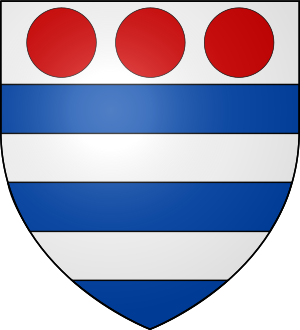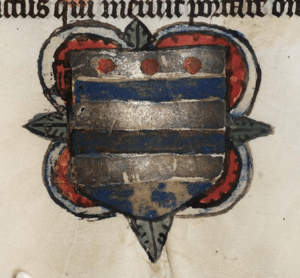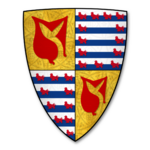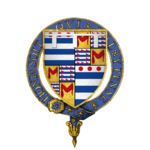Reynold Grey, 3rd Baron Grey of Ruthin facts for kids
Reynold Grey, 3rd Baron Grey of Ruthyn (around 1362 – 30 September 1440), was a powerful lord who controlled lands on the border between England and Wales. He became Baron Grey of Ruthyn after his father passed away in July 1388.
Contents
Family Background
Reynold Grey was the oldest son of Reynold Grey, 2nd Baron Grey of Ruthin and Eleanor Le Strange. His grandparents were Roger Grey, 1st Baron Grey of Ruthin and Elizabeth de Hastings.
Marriages and Children
Reynold Grey married twice and had several children.
First Marriage
After November 1378, Reynold married Margaret de Ros. She was the daughter of Thomas de Ros, 4th Baron de Ros. With Margaret, Reynold had two sons and several daughters, including:
- Sir John Grey, K.G. (around 1387 – 27 August 1439). He was the oldest son who lived long enough, but he passed away before his father. Sir John married Constance Holland. They had children, including Edmund Grey, 1st Earl of Kent.
- Eleanor Grey. She married Robert Poynings, 4th Baron Poynings.
- Margaret Grey. She married William Bonville, 1st Baron Bonville.
Second Marriage
On 7 February 1415, Reynold married Joan de Astley. She was the daughter of Sir William de Astley, 4th Baron Astley. Joan passed away in 1448. With Joan, Reynold had three sons and three daughters, including:
- Sir Edward Grey (around 1415/1416 - 18 December 1457). He married Elizabeth Ferrers. Their son, Sir John Grey of Groby, was the first husband of Elizabeth Woodville, who later became Queen of England.
- Elizabeth Grey. She married Sir William Calthorpe.
Conflict with Owain Glyndŵr
Reynold Grey had a long-standing disagreement with Owain Glyndŵr, a Welsh leader, over land. Grey claimed some of Glyndŵr's land as his own.
Land Disputes and Royal Favor
In 1410, Reynold Grey won the right to use the special family symbols (called 'arms') of the Hastings family. This was important because it showed his high status. He was also given control over some of the Hastings family's properties.
Reynold Grey was well-liked by both King Richard II and King Henry IV. His main military actions were against the Welsh during the rebellion led by Owain Glyndŵr. As a powerful lord, Reynold Grey was in charge of calling local nobles and their men to serve the King.
The Start of the Rebellion
Under King Richard II, the land dispute had been decided in Glyndŵr's favor. However, when King Henry IV took the throne, Lord Grey quickly seized the land. In early September 1400, King Henry IV heard about the growing quarrel between Grey and Glyndŵr. Lord Grey was a member of the King's important council.
Glyndŵr tried to settle the matter legally in 1400, but his case was not heard. Instead, he was asked to give Lord Grey even more land. Lord Grey also purposely delayed telling Glyndŵr to send his men for military service in Scotland. This made it impossible for Glyndŵr to respond or explain why his men were not there. Not following a King's order was seen as an act of treason.
Because of this, Glyndŵr's lands were taken away until he could prove his loyalty. On 16 September, Owain Glyndŵr and his brothers started fighting back. For three days, their Welsh forces attacked and burned Grey's properties. On 24 September, Glyndŵr's forces were surrounded and defeated.
Grey's Capture and Ransom
Lord Grey then invited Glyndŵr to a meeting to make peace. However, Grey arrived with a large group of soldiers, planning to capture Glyndŵr. Glyndŵr managed to escape and went into hiding. This confirmed in English eyes that he was a traitor. King Henry IV took away the lands of Glyndŵr's supporters and gave them to his half-brother, John Beaufort, 1st Earl of Somerset.
The rebellion grew stronger, and by 1402, it was gaining speed. Lord Grey himself was captured by Glyndŵr's forces in an ambush near Ruthin in January. Glyndŵr demanded a large ransom of 10,000 marks for Grey's release. He also made Lord Grey swear an oath never to fight against him again.
King Henry IV sent knights to negotiate with Glyndŵr. The King then agreed to pay the ransom. In mid-1402, he ordered the sale of a manor (a large estate) in Kent to raise the money. Lord Grey was expected to repay this amount over time.
End of the Rebellion
The rebellion eventually failed after the recapture of Harlech Castle. The Grey family later sold their Ruthyn Lordship to King Henry VII in 1508, as their family's power and favor had decreased.
Service in the Hundred Years' War
In 1415, Reynold Grey was part of the Council that governed England while King Henry V was away fighting in France. Later, in 1420 and 1421, he fought against the French in the Hundred Years' War. He had also served as a Lord Lieutenant of Ireland before this.
Images for kids






